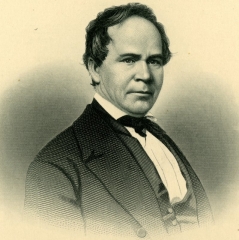But by the late ’50’s, the long-time student interest in maintaining buildings and grounds seems to have given way to an enthusiasm for gymnastic exercises. Through their own endeavors they built a gymnasium in 1858 and equipped it with a trapeze, ropes and rings, and other apparatus. The next year the Trustees hired a janitor to keep the classrooms clean, shovel paths in winter and do other jobs students had usually done.
The need for an auditorium larger than the chapel in West Hall led to the construction of the Hall of Alumni and Friends. In 1858 Henry C. Vogell, Class of 1827, a University Trustee and pastor at Rome, New York, began soliciting subscriptions for a $20,000 building fund. The laying of the cornerstone took place the next year at commencement, with the presidents of Brown and Hamilton as honored guests. Since the Trustees had been unable to agree on a site, three having been considered, the ceremony took place on the north side of East and West Halls. Immediately afterward, however, they chose a location west of these structures. The Cottage Edifice which stood on part of the site was razed and by the following August the new three-story building, 107 feet by 75 feet, was nearly ready for the roof. Observers viewed with great interest the aerial tramway, suggested by Washington A. Roebling who later designed the Brooklyn Bridge, which conveyed the stone for the walls from the University quarry on the Hill above to the workmen below; as the staging was raised the lower end of the tramway was elevated.
One cornerstone, whether the original or not is unknown, carries the proud inscription: “Quod conamur perficimus“
(“We complete what we attempt”
). These were brave words, for only the chapel, which occupied the entire third floor, was finished by August 1861. Vogell’s accounts had not balanced and the Trustees were obliged to borrow additional funds. Nonetheless, dedication exercises were held the day before commencement. The choir and congregation sang two original hymns by Samuel F. Smith, the author of “America.”
The following stanza from the second was eminently fitting for the occasion:
Here may no Science, falsely named,
Thy sacred Word deny –
May error here be shunned and shamed,
In knowledge from on high.
The night prior to the exercises prankster students built a huge






